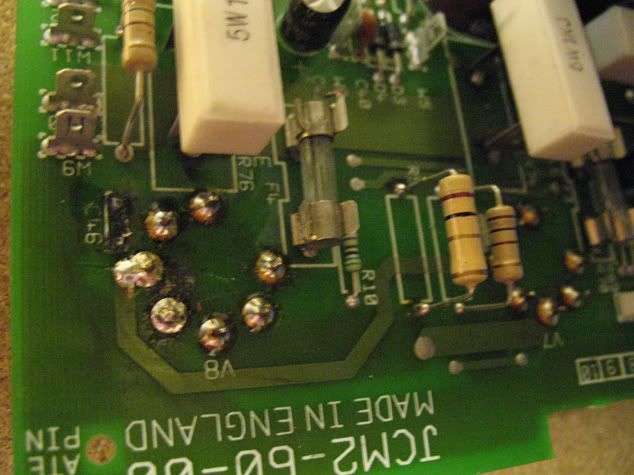Originally posted by Robert M. Martinelli
View Post
Ad Widget
Collapse
Announcement
Collapse
No announcement yet.
DSL 100 noise
Collapse
X
-
That amp may have another very familiar TSL problem, which is bias voltage leaking away under hot conditions. This causes the output tubes to overheat after an hour or two of operation. You can check for it by taking out the power tubes, and blowing hot air at the board from underneath whilst monitoring the bias voltage on a power tube pin 5. If you see it steadily fall away more than a volt or so as the board heats up you will need a new board. Marshall supply these in the UK to appointed techs.
Comment
-
Thanks Alex! As the amp might work well without this cap I believe the problem is due to bias drift. I'll check it out as you suggested!
Trying to find some info about this I found this thread that solves the problem without the cost of a new pcb.
Check it out, TSL122-TSL100 thermal bias drift repair page! The link has a detailed page with the repair and some other upgrades of the pcb.
Comment
-
wow nifty dremel work there. Yes it probably is some kind of leakage like he describes, but if the board gets leaky when it gets hot in one place it's likely going to happen in other places too. When I was experimenting with the hairdryer (and the TSL - not the other hairdryer experiments, I only discuss those with my therapist) I found that it was when the area of the bias caps got hot that the bias voltage dropped. Anyhow, try it yourself and see (and until you do that I wouldn't go believing you've diagnosed it, it could be a whole bundle of other things). I imagine that what's happening is that HT leaks across to the bias voltage somewhere like the guy says.
Since I can get UK approved repairer prices I do the whole Marshall fibreglass board replacement job for £130 plus tubes, which can't be much more than it would cost if I started messing about with my dremel. Not that I'm touting for business or anything, but I do confess this makes my wisdom on the matter about as trustworthy as those tube reviews that tube retailers put on their sites and certain folk lap up like it's gospel.
BTW please don't PM me asking will I get a board for you. No I won't, my relationship with Marshall is worth more to me than is saving you a few quid and doing myself out of a job. Sorry to be a grump but every time I post on this issue someone does that.
Comment
-
Still waiting for a price from my local distributor.
After reading all these threads about the DSL/TSL100 thermal bias drifting problem I read that the new PCBs are a little bit darker and not as smooth like the old ones. Then I checked my amp and it's as described! Dark green and different than the other PCBs in the amp. Is the upgraded one? Also, it has the correct 5K6 stoppers and not carbon resistors like the old ones.
Comment
-
Ok! Don't worry! I'll test it with a hairdryer before I'll order a new board. Just doing some research. The board is outside of the circuit right now and I'm checking it.
Check the photo to see the condition of the board around V8. Especially between pin2 and pin3. Also, you can see the black mark on C46.

Comment
-
That's a fibreglass board. It won't be leaking. Back to square one on that - though you might get somewhere once you've cleaned all that carbon off, that might be causing the problem.
Hats off to you if you did enough marking-up and took enough notes to get it back in again!
Comment
-
Traditional wisdom would say clean with 99% Isopropyl alchohol and cotton swabs or toothbrush, followed by compressed air. I don't find this always works well enough if the sooting is stubborn.Originally posted by spy View PostOh, yes. I keep detailed notes!
About the carbon, how do I clean that black spot? Just by scratching gently the board?
My own personal (not as traditional) method is to start with some oven cleaner (Easy Off or the like) on a cotton swab, followed by toothbrush over the course of a few minutes. Then a liberal dose of spray cleaner (Glass Plus works well) with again a toothbrush plus compressed air, followed last by the Isopropyl alchohol & compressed air method. Best done with the board supported so that the area you are working on is angled to drip onto some paper towels in a garbage can or something rather than run all over the board. I find as a bonus this method very effectively de-fluxes and shines up all the solder joints very nicely. Try not to wet the large cement resistors - everything else in the immediate vicinity should not be harmed in any way.
Comment
-
I clean burnt off boards with alcohol and a Qtip. More stubborn and I chuck a bristle brush into my Dremel and polish it away.
When that little cap burns up, the carbonized board material has to be removed and I use a small milling bit in my Dremel to grind away any blackened material. That often does not leave a pad for a new cap to solder to, but I usually replace the cap by soldering directly between pins 3 and 4 of the socket.Education is what you're left with after you have forgotten what you have learned.
Comment
Comment